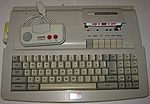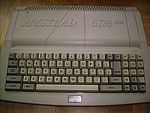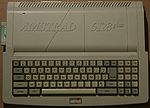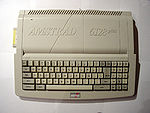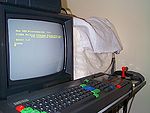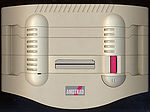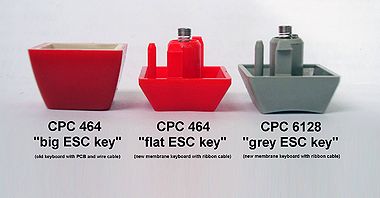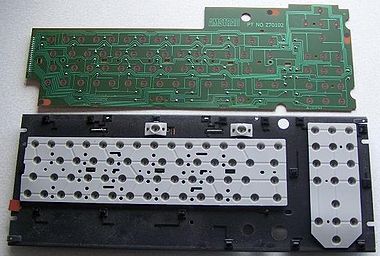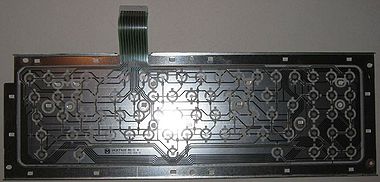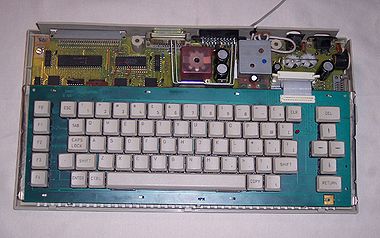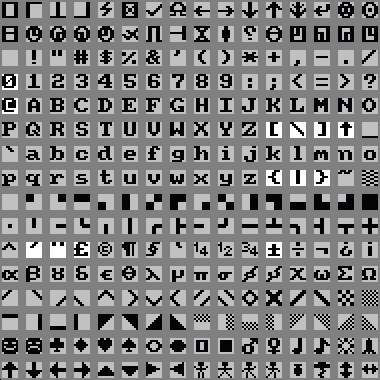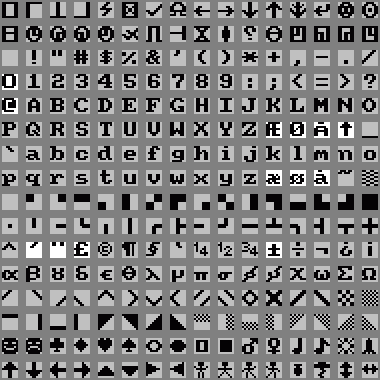Difference between revisions of "Keyboard Versions"
m (Z70102 (CPC464 keyboard picture added)) |
(→Mechanics) |
||
| Line 235: | Line 235: | ||
<br style="clear:both;"> | <br style="clear:both;"> | ||
| − | [[File: | + | [[File:Z70102_disassembled.jpg|380px|left]] |
* '''First 464 Keyboard Circuit (PCB)''' | * '''First 464 Keyboard Circuit (PCB)''' | ||
* Printed-circuit-board with wire-cables. | * Printed-circuit-board with wire-cables. | ||
<br style="clear:both;"> | <br style="clear:both;"> | ||
| − | [[File: | + | [[File:NoPicture.png|100px|left]] |
* '''Second 464 Keyboard Circuit (CPC664-style single-foil)''' | * '''Second 464 Keyboard Circuit (CPC664-style single-foil)''' | ||
* Single "membrane" foil (with 19pin connector) | * Single "membrane" foil (with 19pin connector) | ||
Revision as of 14:37, 1 May 2010
Contents
Unidentified Model
- Amstrad CPC 464 with new logo and grey keys
- Normally grey keys were found only on german Schneider models, not on Amstrad 464.
- Possibly this is a late german model (made after the Schneider/Amstrad partnership ended)...?
- Though this link says it's "most common" in UK...?
- Btw. better "non-diagonal" picture would be nice.
Regions
English
Amstrad Colour Personal Computer
- English CPC 464 (prototype) (more info)
- Prototype with gray case
- English CPC 464 (old logo) (other lowres picture)
- English CPC 464 (new logo)
- English CPC 664
- English CPC 6128 (new logo)
- Surprisingly, this is an ultra rare photo - as by 2010, there are almost no other pictures showing english 128K models in the internet.
- English 464 Plus
- English 6128 Plus
- EPROM in English 464/6128 Plus System Cartridge
- Showing PCB and the sticker with 41xxx-x part number
French
Amstrad Ordinateur Personnel Couleur
Early french models had french plaques on the keyboard and tape/disc drive, but still had english QWERTY keyboards. The french AZERTY keyboards were invented around 1986.
- French CPC 464 (qwerty)
- French CPC 464 (azerty)
- French CPC 664 (qwerty)
- French CPC 6128 (qwerty)
- French CPC 6128 (azerty)
- French CPC 6128 (awerty)
- An AWERTY keyboard (not QWERTY, not AZERTY), with spanish (not french) plaque on the FDD, despite of that without spanish Ñ key on keyboard. Most likely a homebrew modification, not an official product.
- French CPC 6128 (qwerty/rebadged)
- Exotic variant: French 6128 with QWERTY keyboard (english 6128 bundled with french manual & french sticker on FDD - this unit was sold in a french shop, when AZERTY keyboards were out of stock)
- French 464 Plus
- French 6128 Plus
German
Schneider Colour Personal Computer
German CPCs have normal english keyboards. The keyboards (or case) is only different in so far that it is labeled Schneider instead Amstrad, and the 664/6128 have german colour tables on the disc drive. And, the keys are gray, unlike the more colorful Amstrad ones.
- German CPC 464 (Schneider)
- With Schneider logo and grey text on tape drive.
- Grey control keys (unlike multi-colored ones found in other countries).
- German CPC 464 (Amstrad) (should exist?)
- Produced after the Amstrad-Schneider partnership ended in 1988. Now having an Amstrad logo on keyboard, unknown if/how such late german CPCs differed from english CPCs - they might have grey control keys, or german text on tape drive...?
- German CPC 664 (Schneider)
- With Schneider logo and german colour table on disc drive.
- Grey control keys (unlike Blue ones found in other countries).
- German CPC 6128 (Schneider) (one variant)
- With Schneider logo and german colour table on disc drive.
- In this version, the text layout resembles that of the english 6128.
- German CPC 6128 (Schneider) (other variant)
- With Schneider logo and german colour table on disc drive.
- Slightly rearranged text/layout (eg. "Disc Drive" instead of "DISC DRIVE").
- German CPC 6128 (Amstrad)
- Produced after the Amstrad-Schneider partnership ended in 1988. Now having an Amstrad logo on keyboard, but still having a german colour table on the disk drive.
Spanish
Amstrad Ordenador Personal en Color
Before spanish laws led to the 72K fake and to the spanish keyboard, normal english CPCs might have been sold in spain - unknown if this has really happened - and if so, if they had the spanish Ordenador Personal en Color text on them...?
- Spanish CPC 464/664/6128 without Ñ key Pre-472
- According to info from spain: All spanish CPCs (at least the 6128) did have spanish plaques, even before the Ñ key was invented. So, these model(s) should exist. Photos would be welcome!
- EDIT: According to newer info - it now seems they DON'T exist.
- Spanish CPC 472 without Ñ key (more info)
- Early version, still with english keys
- Spanish CPC 472 with Ñ key (more info)
- Later version, with spanish keys
- Spanish CPC 464 with Ñ key
- Spanish CPC 464 with rebadged Ñ key (Schneider)
- With rebadged "spanish" keys (see closeup). And fitted with spanish ROM (see inside).
- Actually a German Schneider model with gray keys. After the Amstrad-Schneider partnership ended, remaining Schneider models were sold all across europe.
- Spanish CPC 6128 with Ñ key (old logo)
- Spanish CPC 6128 with Ñ key (new logo)
- Spanish 464 Plus with Ñ key
- Spanish 6128 Plus with Ñ key
Danish
Amstrad Colour Personal Computer
Older danish 464s had english keys, newer ones (with flat keys) had danish keys...
- Danish CPC 464 (should exist)
- Danish CPC 6128
- BIOS ROM in Danish 464
- Showing the 4xxxx part number on the ROM chip
- BIOS ROM in Danish 6128
- Showing the 4xxxx part number on the ROM chip
Other
- Australian AWA models were shipped with normal english keyboards (with the standard Amstrad logo above the ESC key), the only difference is that LK1 and LK2 are shortened on the mainboard, so the BIOS displays Awa instead of Amstrad in the boot message.
- Greek CPCs are standard english Amstrad models, without any customized logos or keyboard.
- Other countries ... please add some info on Austria, Belgium, USA, etc.
- KC Compact (more info)
- East german CPC clone - lacks some function keys.
- Aleste 520EX (more info)
- Russian CPC clone with russian keyboard - with additional MSX-style function keys.
- GX4000
- Has only one || Pause button (mapped as "P" key in keyboard matrix)
Mechanics
- First 464 Keyboard Circuit (PCB)
- Printed-circuit-board with wire-cables.
- Second 464 Keyboard Circuit (CPC664-style single-foil)
- Single "membrane" foil (with 19pin connector)
- Third 464 Keyboard Circuit (CPC6128-style dual-foil)
- Two membrane foils (with 2x10pin connector)
- CPC 664 Keyboard Circuit
- Single foil (with 19pin connector).
- Connections are closed when the key touches the contacts on the foil.
- Not actually a membrane keyboard (since the foil doesn't move), seems to work more like the old PCB keyboard.
- CPC 6128 Keyboard Circuit
- Two membrane foils (with 2x10pin connector)
- Connections are closed when the key presses the two foils against each other.
- CPC Plus Keyboard Circuit
- Two membrane foils (with 2x10pin connector)
- Same as in CPC 6128, but with connection cable at rear side.
- KC Compact Keyboard Circuit
- PCB with real mechanic switches, possibly the most robust CPC keyboard, even more robust than the early 464 PCB keyboards. Only downside is that it lacks the F5..F9 keys.
Keyboard / Case Dimensions
- CPC 464 - 580x170x70 mm (according to 464 service manual)
- CPC 664 - 580x170x70 mm (according to 664 service manual)
- CPC 6128 - 510x170x48 mm (according to 6128 service manual)
- CPC Plus - 398x297x46 mm (according to 464+/6128+ service manual)
- GX 4000 - 250x184x44 mm (according to 464+/6128+ service manual)
- KC Compact - 399x218x43/54 mm (serviceanleitung) or 388x218x43/54 mm (gerätebeschreibung) (?) or 3388x218x43 mm (!) (www.robotrontechnik.de and www.ddr-rechentechnik.de) (???)
- Aleste 520EX - ???x???x?? mm
Character Set ROMs
Together with the customized keyboards, the BIOS ROMs character sets were changed accordingly. The new characters are potentially useful for home-use, but may result in compatibility problems when importing/exporting software to/from other countries - or even within the same country (the new character sets were invented around 1986, so older french/spanish/danish CPCs didn't support the new symbols).
English
English BIOSes
- 40009 English 464
- 40022 English 664
- 40025 English 6128
- 41???-? English Plus (EPROM in System Cartridge)
Default Symbols
The english BIOSes are also used in german models. Until around 1986 (when localized keyboards/BIOSes were invented), the english BIOSes were also used in spanish/french/danish CPCs.
French
French BIOSes
- 40050 French 464
- 40051 French 6128
- 130Z001 41090-1 French Plus (EPROM in System Cartridge)
Special Symbols
- chr(40h) "à" instead "@"
- chr(5Ch) "ç" instead "\"
- chr(5Eh) "^" with different shape
- chr(7Bh) "é" instead "{"
- chr(7Ch) "ù" instead "|"
- chr(7Dh) "è" instead "}"
- chr(82h) "°" instead umlaut symbol
Changed chr(7Ch) means RSX commands become ùCPM instead |CPM.
The keyboard itself does have both "ù" and "|" keys, but, the default BIOS/BASIC tables do map "ù" to both of them.
Spanish
Spanish BIOSes
- 40037 Spanish 464/472
- 40038 Spanish 6128
- 130Z001 41091-1 Spanish Plus (EPROM in System Cartridge)
Special Symbols
- chr(81h) "Ñ" instead "´"
- chr(83h) "Pt" instead "£"
- chr(8Bh) "ñ" instead "±"
The changed pound/peseta currency symbol may result in some confusion, since the actual exchange rate is unlikely to be 1:1.
Danish
Danish BIOSes
- 40??? Danish 464
- 40??? Danish 6128
- 40???-? Danish Plus (probably doesn't exist?)
Special Symbols
- chr(30h) non-slashed zero, to avoid confusion with letter "Ø"
- chr(5Bh) "Æ" instead "["
- chr(5Ch) "Ø" instead "\"
- chr(5Dh) "Å" instead "]"
- chr(7Bh) "æ" instead "{"
- chr(7Ch) "ø" instead "|"
- chr(7Dh) "å" instead "}"
Similar as in french, RSX commands like "|CPM" become "øCPM".
Notes
- According to soft968 the official language variants are: Spanish, French and Danish. And, presumably, English was official, too.
- Although french/danish charsets don't support "|", even newer user manuals (like french cpc+ manual from 1990) still refer to RSX commands as "|CPM" and describe to press shift+"@" to get the "|".






